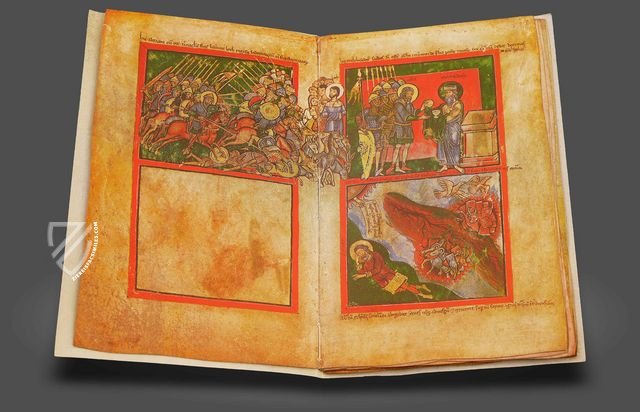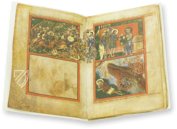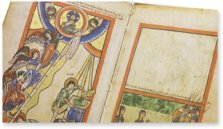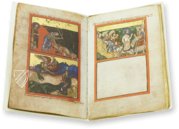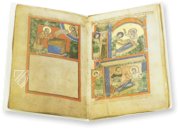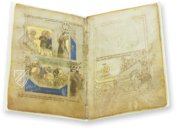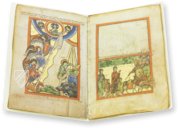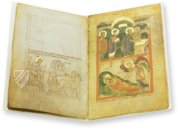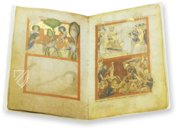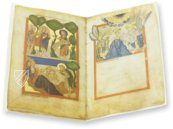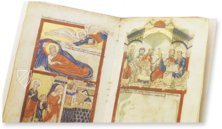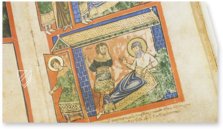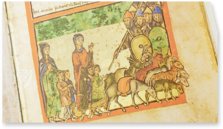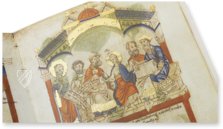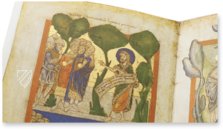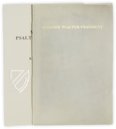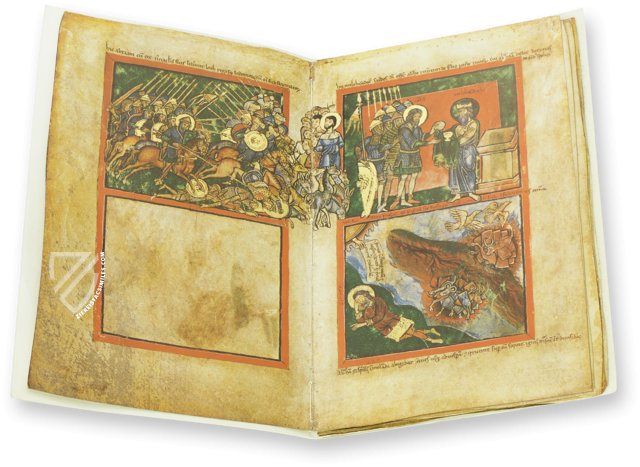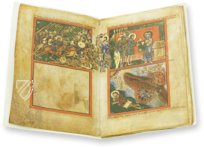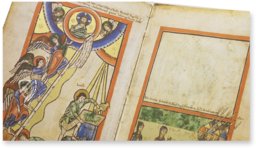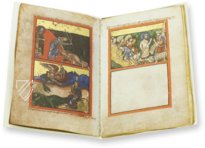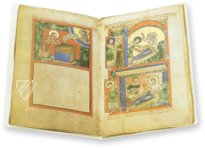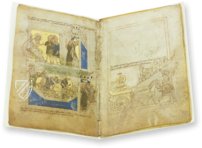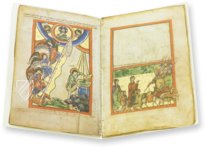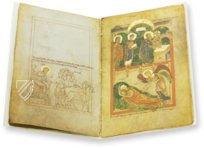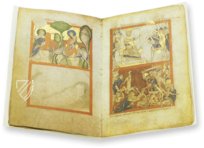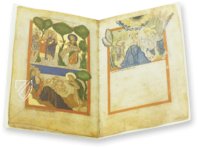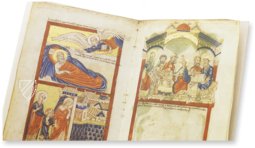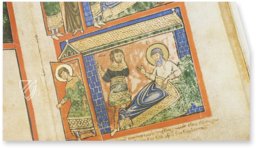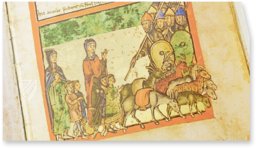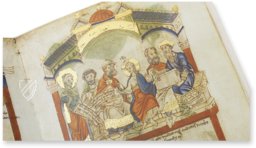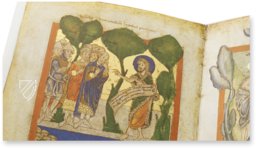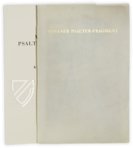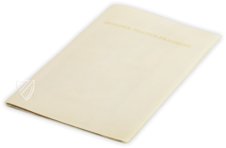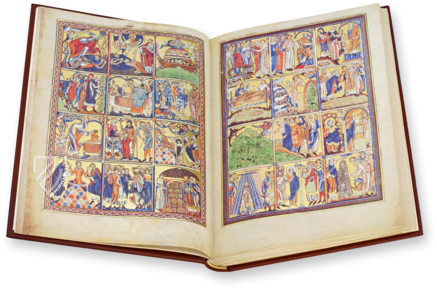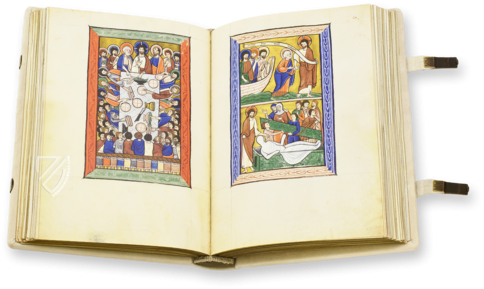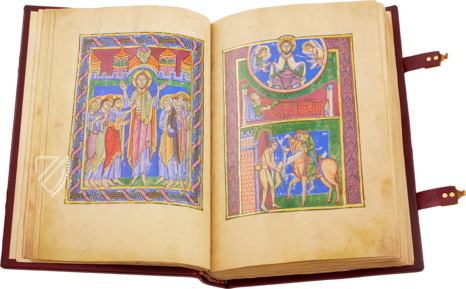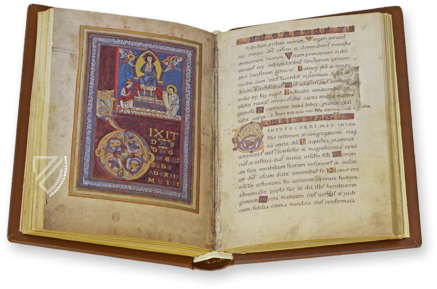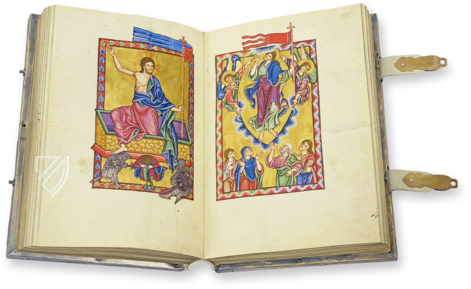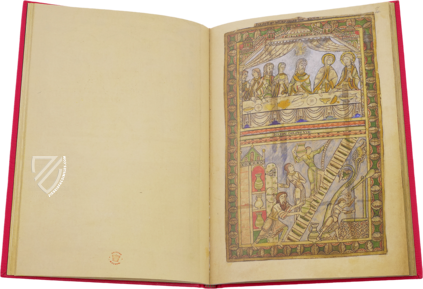Mosan Psalter Fragment
(under 1,000€)
Even though it is not a completed codex, the Mosa Psalter Fragment is nevertheless regarded as a highlight of Romanesque illumination. It is considered to be extremely important in terms of theology, iconography, and history of style. It is a fusion of late-classical, Carolingian, and Ottonian traditions, and in some case, the illustration even evokes the style of modern comic strips. The fact that the manuscript was unfinished, including nearly half of its 29 miniatures, makes it possible to get an inside look into manuscript production at that time, such as in what order miniatures were decorated with various paints and gold leaf. Researchers value the iconography of this psalter fragment very highly, as the miniatures present an iconographic wealth which is very unusual for this period.
Mosan Psalter Fragment
The Mosa Psalter Fragment is a sumptuous manuscript richly embellished with gold, which comprises an illustrated cycle with scenes from both the Old and the New Testaments. Experts consider this fragment to be the introduction to a psalter telling the story of the Bible in pictures. The individual miniatures are merely accompanied by brief thematic indications, so-called "tituli", as well as by some cartouches containing direct speech, recalling our modern comic strips. The magnificent illustrations were made by anonymous masters and are valued as highlights of Romanesque book illumination. The combination of different techniques – pen drawing and opaque color painting – enchants the beholder with its very special charm. The miniatures show landscapes and architecture applied in rich colors and glittering gold as well as lively moving figures that convey a realistic impression of the biblical narrative. This fragment of a Romanesque picture Bible cycle is extremely important in terms of theology, iconography, and history of style. Some compositional elements of the miniatures show late classical, paleo-Christian patterns of Italy as well as influences from the Carolingian and Ottonian traditions.
The Decorative Apparatus
Out of a total of 29 executed miniatures, 15 have been accomplished and 12 have been left unfinished. The two remaining pictures are pen drawings which are partially gilded, an impressive testimony as to how wonderful and of what fine expressive quality unfinished the pen drawings may also be. Moreover, they convey an impression of medieval book production, as the gold was not applied by hand or with a brush at the very end, but immediately after the pen drawing had been completed. The execution of such a comprehensive cycle obviously suggests the collaboration of several artists. However, in spite of the diverseness of techniques, despite the coloring which might have been added by various hands and the stylistic differences visible in some details, it may be assumed that one single master was in charge of artistic aspects, planned the overall design, and was essentially responsible for the execution of the work.
A Precious Fragment of a Picture Bible
Folios 1–6 of this fragment illustrate episodes of the Old Testament, whereas the remaining folios (7–10) depict Gospel scenes. The individual miniatures are set in three-dimensional red frames which the figures frequently exceed, thus lending them a special liveliness. Researchers value the iconography of this psalter fragment very highly, as the miniatures present an iconographic wealth which is very unusual for this period. The manuscript's further importance is expressed in terms of history of style, as it represents a truly prestigious example of late classical influences. The great majority of the pictures go back to Roman monuments of the 5th century. Only in a few cases is there a direct infiltration of purely Eastern, Palestinian-Syrian, or Byzantine traditions.
Codicology
- Alternative Titles
- Das Mosaner Psalter-Fragment
Das Mosaner Psalter-Fragment
Psautier Mosan
Fragments d'un Psautier mosan - Size / Format
- 20 pages / 24.9 × 15.6 cm
- Origin
- France
- Date
- Mid-12th century
- Epochs
- Style
- Genre
- Language
- Illustrations
- Every page is decorated with at least one miniature, 29 in total including 1 full-page miniature
Mosan Psalter Fragment
The Deception of Isaac
As Isaac reached the age of 137, he was blind and nearing death. He thus sent for his son Esau, but his wife Rebecca wanted her own son Jacob to receive the blessing as first among the sons of Isaac. She wraps Jacob’s arms in goatskins to make him seem like his hairy brother Esau. Thus disguised, Jacob brings Isaac his food and receives the blessing. After the deception is revealed, Isaac does not reverse his decision, promising Esau that he will one day have dominion.
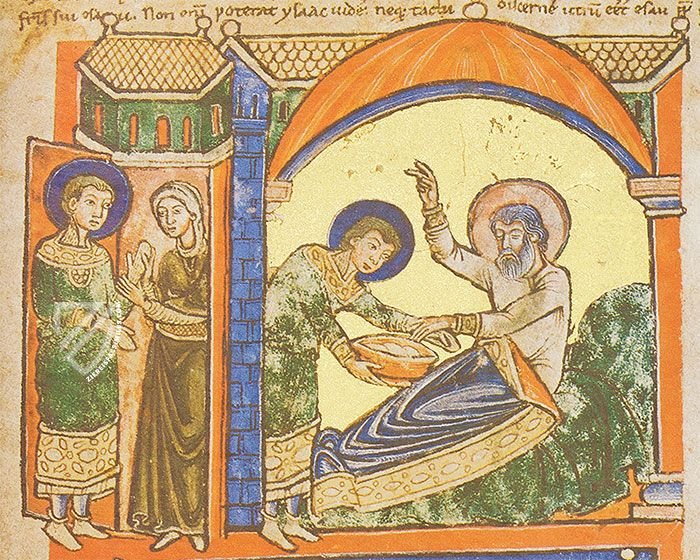
Mosan Psalter Fragment
Jacob’s Ladder
This popular prophecy from the Old Testament is presented here in a Romanesque miniature with clear influences from Islamic and Byzantine art. The highly debated dream of Jacob, patriarch of the Israelites, is an interpretation of the obligations and inheritance of God’s chosen people. In Christian theology, the ladder symbolizes the perpetual intercourse between Heaven and Earth.
In this image, the ladder leads directly to Jesus, representing his fulfillment of Jacob’s dream envisioning the reunion of God and mankind. Jacob is clearly identified, with golden beams of inspiration shining down upon him from above, and the vision emanates from his mind as he lies down in sleep. The ladder he envisions leads up a stream of gold leaf to Heaven.
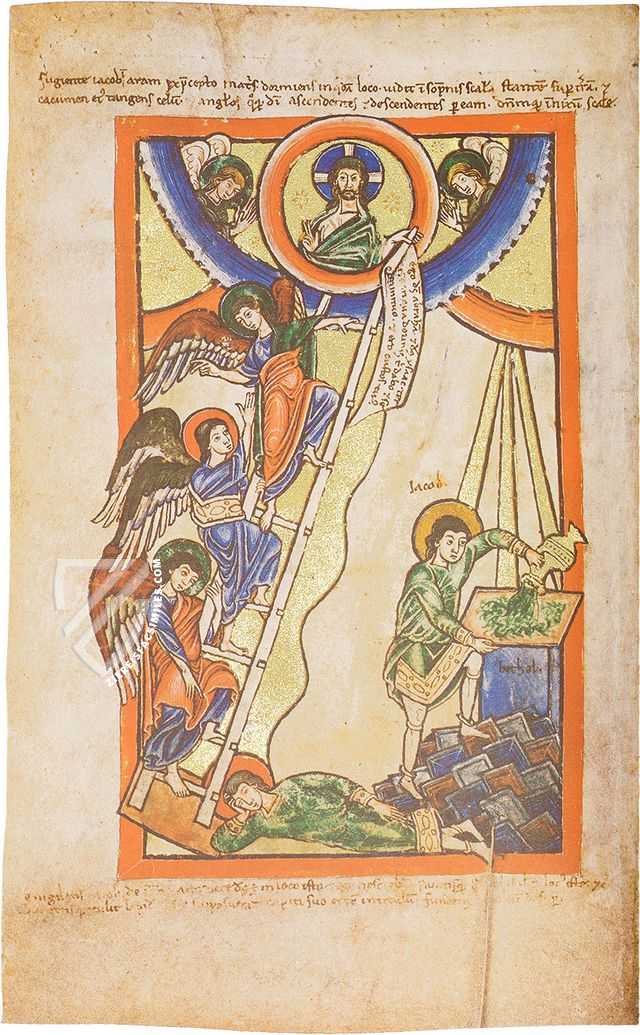
#1 Das Mosaner Psalter-Fragment
Language: German
(under 1,000€)
- Treatises / Secular Books
- Apocalypses / Beatus
- Astronomy / Astrology
- Bestiaries
- Bibles / Gospels
- Chronicles / History / Law
- Geography / Maps
- Saints' Lives
- Islam / Oriental
- Judaism / Hebrew
- Single Leaf Collections
- Leonardo da Vinci
- Literature / Poetry
- Liturgical Manuscripts
- Medicine / Botany / Alchemy
- Music
- Mythology / Prophecies
- Psalters
- Other Religious Books
- Games / Hunting
- Private Devotion Books
- Other Genres
- Afghanistan
- Armenia
- Austria
- Belgium
- Colombia
- Croatia
- Czech Republic
- Denmark
- Egypt
- Ethiopia
- France
- Germany
- Hungary
- India
- Iran
- Iraq
- Israel
- Italy
- Japan
- Luxembourg
- Mexico
- Morocco
- Netherlands
- Peru
- Poland
- Portugal
- Russia
- Serbia
- Spain
- Sri Lanka
- Sweden
- Switzerland
- Syria
- Turkey
- Ukraine
- United Kingdom
- United States
- Uzbekistan
- Aboca Museum
- Ajuntament de Valencia
- Akademie Verlag
- Akademische Druck- u. Verlagsanstalt (ADEVA)
- Aldo Ausilio Editore - Bottega d’Erasmo
- Alecto Historical Editions
- Alkuin Verlag
- Almqvist & Wiksell
- Amilcare Pizzi
- Andreas & Andreas Verlagsbuchhandlung
- Archa 90
- Archiv Verlag
- Archivi Edizioni
- Arnold Verlag
- ARS
- Ars Magna
- ArtCodex
- AyN Ediciones
- Azimuth Editions
- Badenia Verlag
- Bärenreiter-Verlag
- Belser Verlag
- Belser Verlag / WK Wertkontor
- Benziger Verlag
- Bernardinum Wydawnictwo
- BiblioGemma
- Biblioteca Apostolica Vaticana (Vaticanstadt, Vaticanstadt)
- Bibliotheca Palatina Faksimile Verlag
- Bibliotheca Rara
- Boydell & Brewer
- Bramante Edizioni
- Brepols Publishers
- British Library
- C. Weckesser
- Caixa Catalunya
- Canesi
- CAPSA, Ars Scriptoria
- Caratzas Brothers, Publishers
- Carus Verlag
- Circulo Cientifico
- Club Bibliófilo Versol
- Club du Livre
- CM Editores
- Collegium Graphicum
- Collezione Apocrifa Da Vinci
- Comissão Nacional para as Comemorações dos Descobrimentos Portugueses
- Coron Verlag
- Corvina
- CTHS
- D. S. Brewer
- De Agostini/UTET
- De Schutter
- Deuschle & Stemmle
- Deutscher Verlag für Kunstwissenschaft
- DIAMM
- Droz
- E. Schreiber Graphische Kunstanstalten
- Ediciones Boreal
- Ediciones Grial
- Ediclube
- Edições Inapa
- Edilan
- Editalia
- Edition Georg Popp
- Edition Leipzig
- Edition Libri Illustri
- Editiones Reales Sitios S. L.
- Éditions de l'Oiseau Lyre
- Editions Medicina Rara
- Editorial Casariego
- Editorial Mintzoa
- Editrice Antenore
- Editrice Velar
- Edizioni Edison
- Egeria, S.L.
- Eikon Editores
- Electa
- Enciclopèdia Catalana
- Eos-Verlag
- Ephesus Publishing
- Eugrammia Press
- Extraordinary Editions
- Fackelverlag
- Facsimila Art & Edition
- Facsimile Editions Ltd.
- Facsimilia Art & Edition Ebert KG
- Faksimile Verlag
- Feuermann Verlag
- Folger Shakespeare Library
- Franco Cosimo Panini Editore
- Friedrich Wittig Verlag
- Fundación Hullera Vasco-Leonesa
- G. Braziller
- Gabriele Mazzotta Editore
- Gebr. Mann Verlag
- Gesellschaft für graphische Industrie
- Getty Research Institute
- Giovanni Domenico de Rossi
- Giunti Editore
- Graffiti
- Grafica European Center of Fine Arts
- Guido Pressler
- Guillermo Blazquez
- H. N. Abrams
- Harrassowitz
- Helikon
- Hendrickson Publishers
- Henning Oppermann
- Herder Verlag
- Hes & De Graaf Publishers
- Hoepli
- Hortus Deliciarum
- Houghton Library
- Hugo Schmidt Verlag
- Idion Verlag
- Il Bulino, edizioni d'arte
- ILte
- Imago
- Insel Verlag
- Instituto de Estudios Altoaragoneses
- Instituto Nacional de Antropología e Historia
- Istituto dell'Enciclopedia Italiana - Treccani
- Istituto Ellenico di Studi Bizantini e Postbizantini
- Istituto Geografico De Agostini
- Istituto Poligrafico e Zecca dello Stato
- Italarte Art Establishments
- J. Thorbecke
- Jan Thorbecke Verlag
- Johnson Reprint Corporation
- Jugoslavija
- Karl W. Hiersemann
- Kasper Straube
- Kaydeda Ediciones
- Konrad Kölbl Verlag
- Kurt Wolff Verlag
- La Liberia dello Stato
- La Linea Editrice
- La Meta Editore
- Lambert Schneider
- Landeskreditbank Baden-Württemberg
- Leo S. Olschki
- Les Incunables
- Library of Congress
- Libreria Musicale Italiana
- Lichtdruck
- Lito Immagine Editore
- Lumen Artis
- Lund Humphries
- M. Moleiro Editor
- Maison des Sciences de l'homme et de la société de Poitiers
- Manuscriptum
- Maruzen-Yushodo Co. Ltd.
- MASA
- McGraw-Hill
- Militos
- Millennium Liber
- Müller & Schindler
- National Library of Wales
- Neri Pozza
- Nova Charta
- Oceanum Verlag
- Odeon
- Orbis Mediaevalis
- Orbis Pictus
- Österreichische Staatsdruckerei
- Oxford University Press
- Pageant Books
- Parzellers Buchverlag
- Patrimonio Ediciones
- Pattloch Verlag
- PIAF
- Pieper Verlag
- Plon-Nourrit et cie
- Prestel Verlag
- Princeton University Press
- Prisma Verlag
- Priuli & Verlucca, editori
- Pro Sport Verlag
- Propyläen Verlag
- Pytheas Books
- Quaternio Verlag Luzern
- Reales Sitios
- Recht-Verlag
- Reichert Verlag
- Reichsdruckerei
- Riehn & Reusch
- Roberto Vattori Editore
- Rosenkilde and Bagger
- Roxburghe Club
- Salerno Editrice
- Sarajevo Svjetlost
- Schöck ArtPrint Kft.
- Scolar Press
- Scrinium
- Scripta Maneant
- Scriptorium
- Siloé, arte y bibliofilia
- SISMEL - Edizioni del Galluzzo
- Sociedad Mexicana de Antropología
- Sorli Ediciones
- Stainer and Bell
- Styria Verlag
- Sumptibus Pragopress
- Szegedi Tudomànyegyetem
- Taberna Libraria
- Tarshish Books
- Taschen
- Tempus Libri
- Testimonio Compañía Editorial
- Thames and Hudson
- The Clear Vue Publishing Partnership Limited
- The Facsimile Codex
- The Folio Society
- The Marquess of Normanby
- The Richard III and Yorkist History Trust
- Tip.Le.Co
- TouchArt
- TREC Publishing House
- TRI Publishing Co.
- Trident Editore
- Typis Regiae Officinae Polygraphicae
- Universidad de Granada
- University of California Press
- University of Chicago Press
- Urs Graf
- Vallecchi
- Van Wijnen
- VCH, Acta Humaniora
- VDI Verlag
- Verlag für Regionalgeschichte
- Verlag Styria
- Vicent Garcia Editores
- W. Turnowsky
- Wiener Mechitharisten-Congregation (Wien, Österreich)
- Wissenschaftliche Buchgesellschaft
- Xuntanza Editorial
- Zollikofer AG

